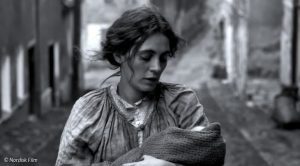40°C in the shade, 16°C in the cinema: the contrasts at the 31st European Film Festival Palić in Serbia, could not have been greater. This is roughly how you can imagine the differences between the 11 films in the Official Selection.
On the one hand, a film like Emilija Gašić’s 78 Days (78 dana), a shaky handheld camera projection in video aesthetics, which was awarded the main prize of the official selection jury. On the other hand, a film like Yorgos Lanthimos’ Kinds of Kindness, a competition film from Cannes, also presented in the Palić Official Selection and serving as the festival’s opening film.
The nightly open-air screenings in a picturesque arena were the best experiences of this fine festival, which shows discoveries from Eastern Europe alongside a wide range of current cinema, especially in the sidebars. The competition films were shown at 9 and 11pm, after which the warm summer evenings turned into film parties, also open air, with live music and cool drinks.
Palić is a small village situated by the lake. The festival organisation did not choose this cosy spa town for nothing to turn the hottest time of the year into a real cinema experience. It was wonderful to spend a whole week outside in consistently pleasant temperatures. The indoor screenings for the jury, on the other hand, were more reminiscent of the cold Berlinale in February, as contrasting as the aforementioned film programme. From genre to comedy, from fake documentary to coming-of-age story, our jury found its winning film, which tells a story that is hard to categorise and sparked fierce debate.
The Girl with the Needle (Pigen med nålen) is Magnus von Horn’s third feature film. Swedish director von Horn is a welcome guest in Palić, as all of his films have been selected for the competition and won awards in recent years. During the screening of his latest in the packed open-air cinema, wisely selected for the late screening at 11pm, quite a few viewers left the arena.

The film shows a gloomy post-WWI female fate in poverty and despair. In a pre-feminist age, von Horn’s protagonist Karoline is a “fallen woman”. Her husband is at war, she has to fend for herself, becomes unemployed and is also unintentionally pregnant. The prevailing patriarchal society doesn’t care about this girl who tries to get rid of her illegitimate child with a needle.
Many viewers compared the narrative style to the Brothers Grimm, where children are given away out of poverty. The director described his movie as a “fairy tale for adults” and was motivated “not just to make a pure genre piece, but to flirt with the genre”.
The story is loosely based on the true-life case of a child murderer who was convicted in Copenhagen at the beginning of the 20th century after she was found guilty of a series of murders of babies apparently entrusted to her for adoption.
The film captivates with its black and white aesthetics (cinematography: Michał Dymek), which emphasises the oppressive atmosphere and is accompanied by an outstanding film set (designed by Jagna Dobesz) of run-down Copenhagen in the year 1919. The characters in the film, on the other hand, blatantly contradict the black and white painting. It is not easy for the viewer to sympathise with them. Everyone is good and bad at the same time. In contrast, the characters unfold their stories, which are rarely told in full, in the minds of the audience, which has to decide for itself to what extent the characters act voluntarily or have to submit to the circumstances.
After two hours of cinema, the many threads of the plot that have been picked up are continued as we reflect on what we have seen. The film demands attitudes. In intensive discussions among the filmmakers, the impossibility of viewing the film as a cinematic experience was discussed. It was essentially about cinema as an entertainment industry. Does the movie exceed the level of unbearable suffering?
For us in the FIPRESCI jury, the film goes beyond the historical drama with genre influence and paints a picture of a society that has lost its humanity. People look away without compassion in order to guarantee the continued existence of an ailing society. How far away are we from this image today? The movie is a trigger and doesn’t let go. The eponymous needle runs through the story as a symbol and stabs again and again.
Bettina Hirsch
Edited by Amber Wilkinson
© FIPRESCI 2024
